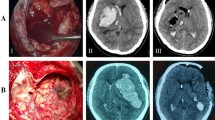Abstract
This study was designed to compare the approaches and efficacies of two different ways of neurosurgical management for spontaneous putaminal hemorrhage (SPH): computed tomographic-guided aspiration (CTGA) and the key-hole approach (KHA). The indications of the two approaches are also explored. From September 2001 to 2003, a total of 1077 cases of SPH distributed in 135 hospitals all over the mainland of China were included for analysis. All cases had three-month follow-up data. The study was designed in a single-blinded manner to compare the efficacies of the different approaches. There were 563 cases in the CTGA group, 165 in the KHA group, and 217 cases in the conventional open craniotomy (COC) group. In the CTGA and KHA groups, the mortalities at one month after operation (M1m) were 17.9% and 18.3%, respectively, while the mortalities at three months after operation (M3m) were 19.4% and 19.4%, respectively (P>0.05). The postoperative complications due to CTGA (23.7%) were not significantly different from those due to KHA (25.7%) (P = 0.420). The M3m of patients with Glasgow coma scale (GCS) ⩽8 was 3.45 and 4.0 times as much as those with GCS>8, respectively. The M3m of patients with complications was 3.92 times as much as those without complications. The M3m of patients with hemorrhage volume ⩾70 mL was 2.67 times as much as those <70 mL. The CTGA is not better than KHA in the treatment of SPH in terms of a more favorable outcome or less mortality and morbidity, but CTGA could be the first choice for those with bleeding volumes ≤50mL, while KHA is the first choice for those with bleeding volumes >50 mL.
Similar content being viewed by others
References
Fernandes H M, Mendelow AD. Spontaneous intracerebral haemorrhage: A surgical dilemma. Br J Neurosurg, 1999, 13(4): 389–394
Fernandes H M, Gregson B, Siddique S, Mendelow A D. Surgery in intracerebral hemorrhage: The uncertainty continues. Stroke, 2000, 31(10): 2511–2516
Hankey G J. Evacuation of intracerebral hematoma is likely to be beneficial-against. Stroke, 2003, 34(6): 1568–1569
Tan S H, Ng P Y, Yeo T T, Wong S H, Ong P L, Venketasubramanian N. Hypertensive basal ganglia hemorrhage: A prospective study comparing surgical and nonsurgical management. Surg Neurol, 2001, 56(5): 287–292; discussion 292–293
Hankey G J, Hon C. Surgery for primary intracerebral hemorrhage: is it safe and effective? A systematic review of case series and randomized trials. Stroke, 1997, 28(11): 2126–2132
Broderick J P, Adams H P Jr, Barsan W, Feinberg W, Feldmann E, Grotta J, Kase C, Krieger D, Mayberg M, Tilley B, Zabramski J M, Zuccarello M. Guidelines for the management of spontaneous intracerebral hemorrhage: A statement for healthcare professionals from a special writing group of the Stroke Council, American Heart Association. Stroke, 1999, 30(4): 905–915
Minematsu K. Evacuation of intracerebral hematoma is likely to be beneficial. Stroke, 2003, 34(6): 1567–1568
Grotta J C. Acute stroke therapy in the millennium: consummating the marriage between the laboratory and the bedside: The Feinberg lecture. Stroke, 1999, 30(8): 1722–1728
Chen X C, Yang H M, Chen Z P. The comparison of surgical and medical treatment of hypertensive cerebral hemorrhage. Fudan University Journal of Medical Sciences, 1992, 19(1): 237–240
Yoon S S, Byles J. Perceptions of stroke in the general public and patients with stroke: A qualitative study. Br Med J, 2002, 324(7345): 1065–1068
Kadojic D, Barac B, Trkanjec Z, Kadojic M. The secular trend in the incidence of hemorrhagic stroke in the region of Osijek, Eastern Croatia in the period 1988—2000—a hospital based study. Coll Antropol, 2002, 26(2): 627–634
Passero S, Ciacci G, Reale F. Potential triggering factors of intracerebral hemorrhage. Cerebrovasc Dis, 2001, 12(3): 220–227
Song E C, Chu K, Jeong S W. Hyperglycemia exacerbates brain edema and perihematomal cell death after intracerebral hemorrhage. Stroke, 2003, 34(9): 2215–2220
Cho S J, Won T K, Hwang S J, Kwon J H. Bilateral putaminal hemorrhage with cerebral edema in hyperglycemic hyperosmolar syndrome. Yonsei Med J, 2002, 43(4): 533–535
Morgenstern L B, Demchuk A M, Kim D H, Frankowski R F, Grotta J C. Rebleeding leads to poor outcome in ultra-early craniotomy for intracerebral hemorrhage. Neurology, 2001, 56(10): 1294–1299
Rabinstein A A, Atkinson J L, Widjicks E F M. Emergency craniotomy in patients worsening due to expanded cerebral hema-toma: to what purpose? Neurology, 2002, 58(9): 1367–1372
Nasser J A, Falavigna A, Bezerra M, Martinez V, Freitas G, Alaminos A, Bonatelli A, Ferraz F. Stereotactic fibrinolysis of spontaneous intracerebral hematoma using infusion of recombinant tissue plasminogen activator. Arq Neuropsiquiatr, 2002, 60(2B): 362–366
Montes J M, Wong J H, Fayad P B, Fayad P B, Awad I A. Stereotactic computed tomographic-guided aspiration and thrombolysis of intracerebral hematoma: Protocol and preliminary experience. Stroke, 2000, 31(4): 834–840
Bernays R L, Kollias S S, Romanowski B, Valavanis A, Yonekawa Y. Near-real-time guidance using intraoperative magnetic resonance imaging for radical evacuation of hypertensive hematomas in the basal ganglia. Neurosurgery, 2000, 47(5): 1081–1089; discussion 1089–1090
Phan T G, Koh M, Vierkant R A. Hydrocephalus is a determinant of early mortality in putaminal hemorrhage. Stroke, 2000, 31: 2157–2162
Klungel O H, Stricker B H, Paes A H, Seidell J C, Bakker A, Vok Z, Breteler M M, de Anthonius B. Excess stroke among hypertensive men and women attributable to undertreatment of hypertension. Stroke, 1999, 30(7): 1312–1318
Bae H, Jeong D, Doh J, Lee K, Yun I, Byun B. Recurrence of bleeding in patients with hypertensive intracerebral hemorrhage. Cerebrovasc Dis, 1999, 9(2): 102–108
Sug Y S, Heller R F, Levi C, Wiggers J, Fitzgerald P E. Knowledge of stroke risk factors, warning symptoms, and treatment among an Australian urban population. Stroke, 2001, 32(8): 1926–1930
Author information
Authors and Affiliations
Corresponding author
Rights and permissions
About this article
Cite this article
Zhao, J., Zhou, L., Zhou, D. et al. Comparison of CT-guided aspiration to key hole craniotomy in the surgical treatment of spontaneous putaminal hemorrhage: a prospective randomized study. Front. Med. China 1, 142–146 (2007). https://doi.org/10.1007/s11684-007-0027-1
Received:
Accepted:
Published:
Issue Date:
DOI: https://doi.org/10.1007/s11684-007-0027-1




